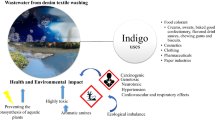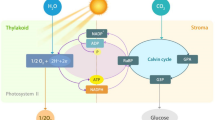Abstract
Dissolved black carbon (DBC) is regarded as an important part of the natural organic matter pool. However, it is unclear about DBC’s photochemical activity and the relationships between reactive intermediates (RIs) and the molecular structure of DBC remain unclear. In this study, we investigate the photochemical formation ability of RIs and spectral parameters (E2/E3, S275–295) of DBC made from five types of plants at five pyrolysis temperatures. The results showed that there were good linear regressions between the RI quantum yields and the spectral parameters (E2/E3, S275–295), and this was indicative of the RI generation prediction from DBC under solar irradiation. The DBC-mediated photochemical experiment of sulfadiazine revealed that 3DBC* was the primary active species for the indirect photodegradation of sulfadiazine. Further studies indicated that a linear relationship was observed between the indirect photodegradation ability of sulfadiazine induced directly by 3DBC* at different pyrolysis temperatures and the 3DBC* quantum yields or E2/E3. These findings indicate that the simple models of the RI quantum yield as a function of spectral parameters can be used to evaluate the degradation of pollutants with known DBC spectral parameters.






Similar content being viewed by others
Data availability
All data generated or analyzed during this study are included in this published article.
References
Boreen AL, Arnold WA, McNeil K (2005) Triplet-sensitized photodegradation of sulfa drugs containing six-membered heterocyclic groups: identification of an SO2 extrusion photoproduct. Environ Sci Technol 39(10):3630
Boyle ES, Guerriero N, Thiallet A, Vecchio RD, Blough NV (2009) Optical properties of humic substances and CDOM: relation to structure. Environ Sci Technol 43:2262–2268
Canonica S, Hellrung B, Wirz J (2000) Oxidation of phenols by triplet aromatic ketones in aqueous solution. J Phys Chem A 104:1226–1232
Carder KL, Steward RG, Harvey GR, Ortner PB (1989) Marine humic and fulvic acids: their effects on remote sensing of ocean chlorophyll. Limnol Oceanogr 34:68–81
Cavani L, Halladja S, Ter Halle A, Guyot G, Corrado G, Ciavatta C, Boulkamh A, Richard C (2009) Relationship between photosensitizing and emission properties of peat humic acid fractions obtained by tangential ultrafiltration. Environ Sci Technol 43:4348–4354
Coelho C, Guyot G, Halle AT, Cavani L, Ciavatta C, Richard C (2011) Photoreactivity of humic substances: relationship between fluorescence and singlet oxygen production. Environ Chem Lett 9:447–451
Dalrymple RM, Carfagno AK, Sharpless CM (2010) Correlations between dissolved organic matter optical properties and quantum yields of singlet oxygen and hydrogen peroxide. Environ Sci Technol 44:5824–5829
Dalzell BJ, Minor EC, Mopper KM (2009) Photodegradation of estuarine dissolved organic matter: a multi-method assessment of DOM transformation. Organic Geochem 40:243–257
Du Z, He Y, Fan J, Fu H, Zheng S, Xu Z, Qu X, Kong A, Zhu D (2018) Predicting apparent singlet oxygen quantum yields of dissolved black carbon and humic substances using spectroscopic indices. Chemosphere 194:405–413
Ehrenberg B, Anderson JL, Foote CS (1998) Kinetics and yield of singlet oxygen photosensitized by hypericin in organic and biological media. Photochem Photobiolol 68:135–140
Fichot CG, Benner R (2012) The spectral slope coefficient of chromophoric dissolved organic matter (S275–295) as a tracer of terrigenous dissolved organic carbon in river-influenced ocean margins. Sci Limnol Oceanogr 57:1453–1466
Fu H, Liu H, Mao J, Chu W, Li Q, Alvarez P, Qu X, Zhu D (2016) Photochemistry of dissolved black carbon released from biochar: reactive oxygen species generation and phototransformation. Environ Sci Technol 50:1218–1226
Fu H, Wei C, Qu X, Zhu D (2018) Strong binding of apolar hydrophobic organic contaminants by dissolved black carbon released from biochar: a mechanism of pseudomicelle partition and environmental implications. Environ Pollut 232:402–410
Haag WR, Hoigne J, Gassman E, Braun AM (1984) Singlet oxygen in surface waters—part I: furfuryl alcohol as a trapping agent. Chemosphere 13:631–640
Halladja S, Halle AT, Aguer J, Boulkamh A, Richard C (2007) Inhibition of humic substances mediated photooxygenation of furfuryl alcohol by 2,4,6-trimethylphenol: an evidence for reactivity of the phenol with humic triplet excited states. Environ Sci Technol 41:6066–6073
He P, Xue J, Shao L, Li G, Lee DJ (2006) Dissolved organic matter (DOM) in recycled leachate of bioreactor landfill. Water Res 40:1465–1473
Helms JR, Mao JD, Stubbins A, Schmidt-Rohr K, Spencer R, Hernes PJ, Mopper K (2014) Loss of optical and molecular indicators of terrigenous dissolved organic matter during long-term photobleaching. Aquat Sci 76:353–373
Helms JR, Stubbins A, Ritchie JD, Minor EC (2008) Absorption spectral slopes and slope ratios as indicators of molecular weight, source, and photobleaching of chromophoric dissolved organic matter. Limnol Oceanogr 53(3):955–969
Jaffé R, Ding Y, Jutta Niggemann, Vähätalo AV, Stubbins A, Spencer R, Campbell J, Dittmar T (2013) Global charcoal mobilization from soils via dissolution and riverine transport to the oceans. Science 340:345–347
Laszakovits JR, Berg SM, Anderson BG, O’Brien JE, Wammer KH, Sharpless CM (2016) p-Nitroanisole/pyridine and p-Nitroacetophenone/pyridine actinometers revisited: quantum yields in comparison to ferrioxalate. Environ Sci Technol 4:11–14
Lee E, Glover CM, Rosario-Ortiz FL (2013) Photochemical formation of hydroxyl radical from effluent organic matter: role of composition. Environ Sci Technol 47:12073–12080
Li Y, Chen J, Qiao X, Zhang H, Zhang Y, Zhou C (2016) Insights into photolytic mechanism of sulfapyridine induced by triplet-excited dissolved organic matter. Chemosphere 147:305–310
Li Y, Niu J, Wang W (2011) Photolysis of enrofloxacin in aqueous systems under simulated sunlight irradiation: kinetics, mechanism and toxicity of photolysis products. Chemosphere 85:892–897
McCabe AJ, Arnold WA (2016) Seasonal and spatial variabilities in the water chemistry of prarie pothole wetlands influence the photoproduction of reactive intermediates. Chemosphere 155:640–647
McKay G, Couch KD, Mezyk SP, Rosario-Ortiz FL (2016) Investigation of the coupled effects of molecular weight and charge transfer interactions on the optical and photochemical properties of dissolved organic matter. Environ Sci Technol 50:8093–8102
McKay G, Huang WX, Romera-Castillo C, Crouch JE, Rosario-Ortiz FL, Jaffé R (2017) Predicting reactive intermediate quantum yields from dissolved organic matter photolysis using optical properties and antioxidant capacity. Environ Sci Technol 51:5404–5413
McNeil K, Canonica S (2016) Triplet state dissolved organic matter in aquatic photochemistry: reaction mechanisms, substrate scope, and photophysical properties. Environ Sci Process Impacts 18:1381–1399
Mostafa S, Rosario-Ortiz FL (2013) Singlet oxygen formation from wastewater organic matter. Environ Sci Technol 47:8179–8186
Niu J, Li Y, Wang W (2013) Light-source-dependent role of nitrate and humic acid in tetracycline photolysis: kinetics and mechanism. Chemosphere 92:1423–1429
Page SE, Arnold WA, McNeil K (2011) Assessing the contribution of free hydroxyl radical in organic matter-sensitized photohydroxylation reactions. Environ Sci Technol 45:2818–2825
Peterson BM, McNally AM, Cory RM, Thoemke JD, Cotner JB, McNeil K (2012) Spatial and temporal distribution of singlet oxygen in lake superior. Environ Sci Technol 46:7222–7229
Peuravuori J, Pihlaja K (1997) Molecular size distribution and spectroscopic properties of aquatic humic substances. Anal Chim Acta 337:133–149
Qu X, Fu H, Mao J, Ran Y, Zhang D, Zhu D (2016) Chemical and structural properties of dissolved black carbon released from biochars. Carbon 96:759–767
Richard C, Trubetskaya O, Trubetskoj O, Reznikova O, Afanas’Eva G, Aguer J-P, Guyot G (2004) Key role of the low molecular size fraction of soil humic acids for fluorescence and photoinductive activity. Environ Sci Technol 38:2052–2057
Sharpless CM (2012) Lifetimes of triplet dissolved natural organic matter (DOM) and the effect of NaBH4 reduction on singlet oxygen quantum yields: implications for DOM photophysics. Environ Sci Technol 46:4466–4473
Sharpless CM, Blough NV (2014) The importance of charge transfer interactions in determining chromophoric dissolved organic matter (CDOM) optical and photochemical properties. Environ Sci Process Impacts 16:654
Sun P, Pavlostathis SG, Huang C-H (2014) Photodegradation of veterinary ionophore antibiotics under UV and solar irradiation. Environ Sci Technol 48:13188–13196
Tian Y, Feng L, Wang C, Liu Y, Zou J, Du Z, Zhang L (2019) Dissolved black carbon enhanced the aquatic photo-transformation of chlortetracycline via triplet excited-state species: the role of chemical composition. Environ Res 179:108855
Timko SA, Romera-Castillo C, Jaffé R, Cooper WJ (2014) Photo-reactivity of natural dissolved organic matter from fresh to marine waters in the Florida Everglades, USA. Environ Sci Process Impacts 16:866–878
Tratnyek PG, Hoigne J (1994) Photo-oxidation of 2,4,6-trimethylphenol in aqueous laboratory solutions and natural waters: kinetics of reaction with singlet oxygen. J Photochem Photobiol Chem 84:153–160
Twardowski MS, Boss E, Sullivan JM, Donaghay PL (2004) Modeling the spectral shape of absorption by chromophoric dissolved organic matter. Mar Chem 89:69–88
Vaughan PP, Thomas-Smith TE, Blough NV (1998) Photochemical production of the hydroxyl radical by constituents of natural waters. Environmental Science & Technology 32:2947–2953
Wagner S, Stubbins A, Jaffé R (2018) Dissolved black carbon in aquatic ecosystems. Limnol Oceanogr Lett 3:168–185
Wan D, Sharma VK, Liu L, Zuo Y, Chen Y (2019) Mechanistic insight into the effect of metal ions on photogeneration of reactive species from dissolved organic matter. Environ Sci Technol 53:5778–5786
Wang H, Zhou H, Ma J, Nie J, Yan S, Song W (2020) Triplet photochemistry of dissolved black carbon and its effects on the photochemical formation of reactive oxygen species. Environ Sci Technol 54:4903–4911
Weishaar JL, Aiken GR, Bergamaschi BA, Fram MS, Fujii R, Mopper K (2003) Evaluation of specific ultraviolet absorbance as an indicator of the chemical composition and reactivity of dissolved organic carbon. Environ Sci Technol 37:4702–4708
Wenk J, Von Gunten U, Canonica S (2011) Effect of dissolved organic matter on the transformation of contaminants induced by excited triplet states and the hydroxyl radical. Environ Sci Technol 45:1334–1340
Wilkinson F, Helman WP, Ross AB (1993) Quantum yields for the photosensitized formation of the lowest electronically excited singlet state of molecular oxygen in solution. J Phys Chem Ref Data 22:113–262
Xu F, Wei C, Zeng Q, Li X, Alvarez PJJ, Li Q, Qu X, Zhu D (2017) Aggregation behavior of dissolved black carbon: implications for vertical mass flux and fractionation in aquatic systems. Environ Sci Technol 51:13723–13732
Zafiriou OC, Joussotdubien J, Zepp RG, Zika RG (1984) Photochemistry of natural waters. Environ Sci Technol 18:A358–A371
Zhou H, Lian L, Yan S, Song W (2017) Insights into the photo-induced formation of reactive intermediates from effluent organic matter: the role of chemical constituents. Water Res 112:120–128
Zhou H, Yan S, Lian L, Song W (2019) Triplet-state photochemistry of dissolved organic matter: triplet-state energy distribution and surface electric charge conditions. Environ Sci Technol 53:2482–2490
Zhou Z, Chen B, Qu X, Fu H, Zhu D (2018) Dissolved black carbon as an efficient sensitizer in the photochemical transformation of 17β-estradiol in aqueous solution. Environ Sci Technol 52:10391–10399
Zhou C, Xie Q, Wang J, Chen X, Niu J, Chen J (2020) Effects of dissolved organic matter derived from freshwater and seawater on photodegradation of three antiviral drugs. Environ Pollut 258:113700–113707
Funding
This research was financially supported by the National Natural Science Foundation of China (21707058) and the Natural Science Foundation for Excellent Young Scholars of Yunnan Province (2019FI004).
Author information
Authors and Affiliations
Contributions
Yina Tu: investigation, data curation, validation, formal analysis, visualization, writing — original draft, writing — review and editing. Huaying Liu: investigation, data curation, formal analysis. Yingjie Li: conceptualization, methodology, writing — original draft, supervision, writing — review and editing, funding acquisition, project administration. Zhiyu Zhang: resources, writing — review and editing, visualization. Yajie Lei: formal analysis, writing — review and editing. Qun Zhao: supervision, writing — review and editing, project administration. Senlin Tian: conceptualization, writing — review and editing, project administration, supervision.
Corresponding authors
Ethics declarations
Ethics approval and consent to participate
Not applicable.
Consent for publication
We all agree that the Environmental Science and Pollution Research will publish this paper.
Competing interests
The authors declare no competing interests.
Additional information
Responsible Editor: Sami Rtimi
Publisher’s note
Springer Nature remains neutral with regard to jurisdictional claims in published maps and institutional affiliations.
Supplementary Information
Below is the link to the electronic supplementary material.
Rights and permissions
About this article
Cite this article
Tu, Y., Liu, H., Li, Y. et al. Radical chemistry of dissolved black carbon under sunlight irradiation: quantum yield prediction and effects on sulfadiazine photodegradation. Environ Sci Pollut Res 29, 21517–21527 (2022). https://doi.org/10.1007/s11356-021-17379-5
Received:
Accepted:
Published:
Issue Date:
DOI: https://doi.org/10.1007/s11356-021-17379-5




